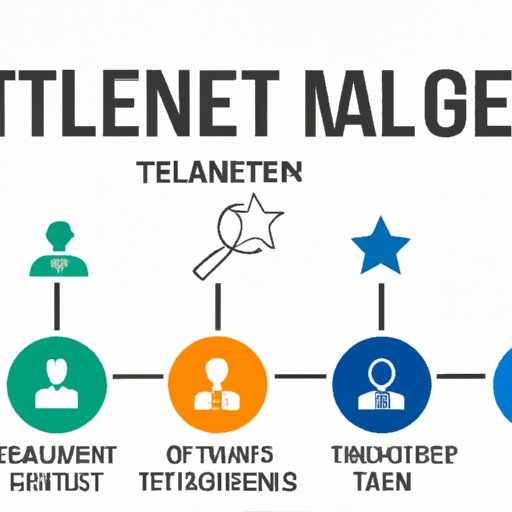Introduction
Effective talent management is essential for companies seeking to thrive in today’s fast-paced and dynamic marketplace. Access to the right talent can be a significant competitive advantage, helping organizations to stay ahead of the curve and outperform their rivals. However, talent management is more than just hiring the best and brightest; it must be strategically aligned with organizational goals and tailored to meet specific business needs. In this article, we explore the concept of strategic talent management, outlining what it is, why it’s important, and how organizations can implement it to their advantage.
Defining Strategic Talent Management: A Comprehensive Overview
Strategic talent management involves the systematic identification, recruitment, development, and retention of talent to achieve business goals. It is an ongoing process that must be aligned with an organization’s overall strategic objectives and grounded in evidence-based practices.
Specific components of strategic talent management include:
- Workforce planning and forecasting
- Identifying critical talent needs
- Developing recruitment strategies to attract top talent
- Performance management
- Succession planning and leadership development
- Employee engagement and retention
- Metrics and analytics to monitor and improve talent management practices
How organizations define strategic talent management may vary, depending on factors such as their industry, size, and unique challenges. However, the key is to ensure that talent management is integrated into the overall business strategy and not treated as an afterthought.
Why Strategic Talent Management Matters and How to Implement It
Strategic talent management is essential for organizational success. It enables organizations to:
- Identify and develop the skills and knowledge necessary to achieve business goals
- Attract and retain top talent
- Bolster the organization’s culture and brand
- Respond effectively to changes in the internal and external environment
To implement strategic talent management, organizations should:
- Align talent management practices with overall business strategy
- Develop a talent management framework that is evidence-based and supported by data
- Provide training and development opportunities to nurture the skills and knowledge of current employees
- Ensure that employee performance is aligned with business goals
- Identify and develop future leaders through succession planning
- Cultivate a culture of engagement and retention
- Use metrics and analytics to measure the effectiveness of talent management practices and make necessary adjustments
The Benefits of Strategic Talent Management for Business Success
Implementing strategic talent management offers several immediate and long-term benefits, including:
- Increased competitiveness through access to top talent
- Increased productivity and profitability due to a more engaged and motivated workforce
- Greater flexibility and responsiveness to change
- Improved employee satisfaction and retention rates
- Increased innovation and creativity through a more diverse and inclusive workforce
Evidence-based research supports the positive impact of strategic talent management on organizational outcomes. For example, a study by McKinsey found that organizations with strong talent management practices outperformed their peers by 22% in profitability, 23% in employee retention, and 66% in leadership strength.
Best Practices for Strategic Talent Management: Tips and Strategies
Implementing strategic talent management requires a thoughtful and comprehensive approach. Here are some best practices for success:
- Link talent management practices to business strategy
- Obtain buy-in from senior leadership and other stakeholders
- Develop a talent management framework grounded in evidence-based practices
- Continuously evaluate and adjust talent management practices based on data and feedback
- Invest in training and development opportunities to nurture employee skills and knowledge
- Foster a culture of engagement and retention through fair and competitive compensation and opportunities for growth and career advancement
- Be open to change and willing to adapt talent management practices to meet internal and external challenges
Examples of when strategic talent management has succeeded include companies such as Zappos, Google, and Southwest Airlines, which have developed talent management frameworks that align with their overall business strategy and promote a culture of engagement and retention. These organizations have reaped the benefits of a more engaged and motivated workforce, resulting in improved business outcomes.
Common Challenges of Strategic Talent Management and How to Overcome Them
Implementing strategic talent management is not without its challenges. Common obstacles include lack of buy-in from senior leadership, difficulty in identifying critical talent needs, resistance to change, and gaps in data and metrics to support talent management efforts.
To overcome these challenges, organizations should:
- Educate senior leadership and stakeholders on the value and importance of strategic talent management
- Invest in research and metrics to identify and track critical talent needs
- Be open to change and willing to experiment with new approaches to talent management
- Regularly evaluate and adjust talent management practices based on data and feedback
Examples of how organizations have triumphed over these challenges include Hewlett-Packard, which turned around its talent management practices by investing in research and metrics to identify critical talent needs, and General Electric, which developed a comprehensive talent management framework that aligned with its overall business objectives and promoted a culture of engagement and retention.

Case Studies: How Companies Have Implemented Strategic Talent Management Successfully
Many companies have successfully implemented strategic talent management practices, resulting in improved business outcomes. Some notable examples include:
- Zappos, which has created a workplace culture that celebrates employee engagement and retention, resulting in high levels of customer satisfaction and profitability
- Google, which has invested heavily in training and development opportunities to nurture employee skills and knowledge, resulting in high levels of innovation and creativity
- Southwest Airlines, which has developed a talent management framework that aligns with its overall business objectives and promotes a culture of customer service and engagement, resulting in increased customer satisfaction and profitability
Analysis of these successful implementations reveals that key success factors include senior leadership buy-in, evidence-based talent management frameworks, and a culture of engagement and retention.
Conclusion
Strategic talent management is essential for organizations seeking to succeed in today’s dynamic business environment. By aligning talent management practices with overall business strategy, investing in training and development opportunities, fostering a culture of engagement and retention, and using metrics and analytics to measure and adjust talent management practices, organizations can improve business outcomes, increase competitiveness, and stay ahead of the curve.
It’s time for organizations to prioritize talent management as a strategic business imperative. By doing so, they can unlock the power of strategy and unleash the full potential of their workforce.
(Note: Is this article not meeting your expectations? Do you have knowledge or insights to share? Unlock new opportunities and expand your reach by joining our authors team. Click Registration to join us and share your expertise with our readers.)
